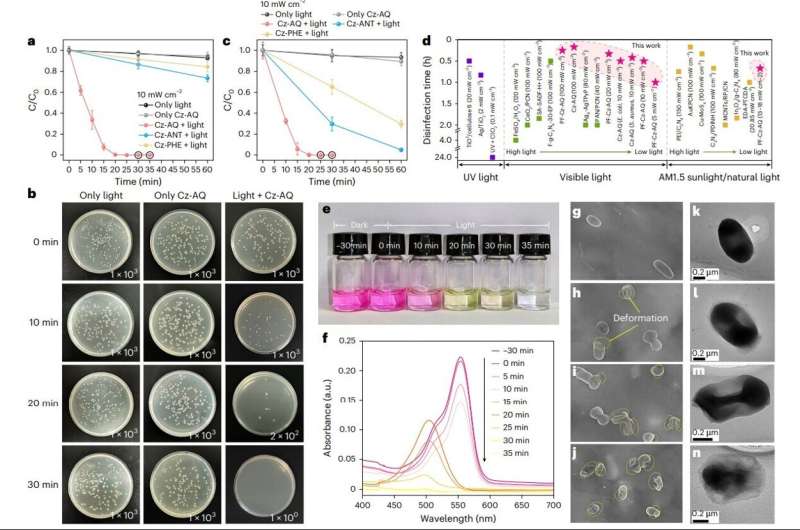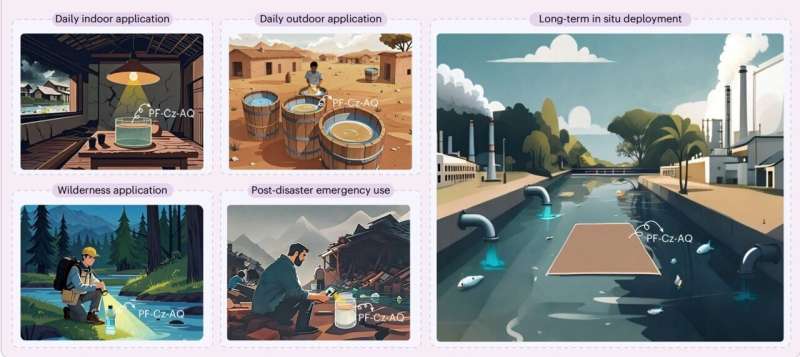Thin solar-powered films purify water by killing bacteria even in low sunlight
Around 4.4 billion people worldwide still lack reliable access to safe drinking water. Newly designed, thin floating films that harness sunlight to eliminate over 99.99% of bacteria could help change that, turning contaminated water into a safe resource and offering a promising solution to this urgent global challenge.
In a recent study, researchers from Sun Yat-sen University, China, presented a self-floating photocatalytic film composed of a specially designed conjugated polymer photocatalyst (Cz-AQ) that generates oxygen-centered organic radicals (OCORs) in water.
These OCORs are efficiently formed due to the strong electron-donating and accepting groups incorporated into the polymer design, resulting in lifetimes orders of magnitude longer than those of conventional reactive oxygen species. With more time to act, the radicals enable the film to break down organic pollutants and suppress bacterial regrowth for at least five days.
The findings published in Nature Water also highlighted that the film can be reused over 50 times while maintaining both stability and cost-effectiveness.
Lack of safe drinking water gives rise to waterborne diseases that claim up to 2 million lives every year, and many of them are young children. The challenge is especially severe in remote and low-income regions, where setting up large centralized treatment plants is not feasible and supporting infrastructure—such as a continuous electricity supply—is often unavailable.

Over the years, several small-scale methods, including chlorination, UV treatment, and solar disinfection (SODIS), have been explored as alternatives. Yet these approaches fall short as chlorination can produce harmful chemical byproducts, UV treatment requires significant energy input, and SODIS is extremely slow, sometimes taking up to 48 hours to work on cloudy days.
Photocatalytic systems emerged as a promising way to tackle water contamination without the need for large infrastructure. However, there is one factor that has prevented current systems from reaching their full potential: their reliance on reactive oxygen species (ROS), which survive for only nanoseconds to microseconds in a real-world setting.
These unstable chemical species are quickly neutralized by side reactions in the environment, making these tiny weapons powerless even before they can attack the microbes they’re meant to destroy.
This new ultrathin film overcame these issues as the radicals generated by the photocatalyst Cz-AQ lasted for nearly 14 minutes in water. To test its efficiency, researchers conducted laboratory testing using E. coli and Staphylococcus aureus bacteria. The film achieved >4.3-log (over 99.995%) bacterial inactivation in 10 liters of highly contaminated water within just 40 minutes.

Unlike conventional TiO₂ and graphene-based photocatalysts, which become almost ineffective under cloudy skies or low sunlight, this film maintained its performance even under such challenging low-light conditions. The researchers note that the level of performance could provide safe drinking water for four to five adults daily.
They also note that this thin, floatable film offers a simple, portable, and affordable solution for providing microbially safe drinking water. If scaled up effectively, this technology can bring safe water to remote communities and disaster-affected areas while also offering a reliable long-term solution for everyday use.
Written for you by our author Sanjukta Mondal, edited by Sadie Harley, and fact-checked and reviewed by Robert Egan—this article is the result of careful human work. We rely on readers like you to keep independent science journalism alive.
If this reporting matters to you,
please consider a donation (especially monthly).
You’ll get an ad-free account as a thank-you.
More information:
Yuyan Huang et al, Reusable photocatalytic film for efficient water disinfection under low light intensity, Nature Water (2025). DOI: 10.1038/s44221-025-00500-0
© 2025 Science X Network
Citation:
Thin solar-powered films purify water by killing bacteria even in low sunlight (2025, October 6)
retrieved 6 October 2025
from https://techxplore.com/news/2025-10-thin-solar-powered-purify-bacteria.html
This document is subject to copyright. Apart from any fair dealing for the purpose of private study or research, no
part may be reproduced without the written permission. The content is provided for information purposes only.

Comments are closed